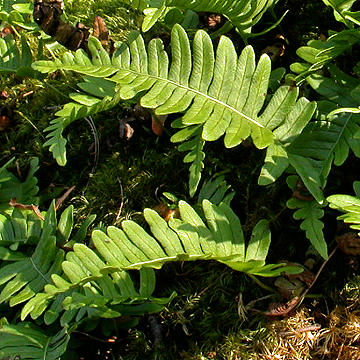

Polypodium virginianum - (image 1 of 5)
Taxonomy
Family: Polypodiaceae
Habitat
Rocky limestone and sandstone cliffs. Steep slopes of wooded dunes.
Associates
On limestone with Aquilegia canadensis, Campanula rotundifolia, Cystopteris bulbifera, Pellaea glabella. On sandstone with Cerastium arvense villosum, Diervilla lonicera, Hedeoma hispida, Juniperus virginiana crebra, Linaria canadensis, Lonicera prolifera, Ostrya virginiana, Selaginella rupestris.
Distribution
Newfoundland to Manitoba, south to GA, AL, TN, AR, MO, IA, SD, and MN
Morphology
Evergreen fern from a creeping rootstock, to 12" high. Leaves oblong lanceolate or triangular; 10 to 20 pairs of long, rounded lobes, 3-5 times longer than wide, cut almost to the stem (pinnatifid); stalk about 1/3 length of leaf. Fruit dots large, round, gold-brown, mostly on upper portion of leaves.
Notes
Spores from mid October to late November
Wetland indicator: Upland
This fern is epipetric, often seen growing on rocks in mountainous regions, occasionally terrestrial or epiphytic on trees.
References
Cobb, B. 1984. A Field Guide to Ferns and Their Related Families.
Houghton Mifflin Co., New York, NY
Lellinger, D. B. and M. Evans. 1985. A Field Manual of the Ferns & Fern Allies
of the United States and Canada.
Smithsonian Institution Press. Washington, D.C.
Swink, F. and G. Wilhelm. 1994. Plants of the Chicago Region.
Indiana Academy of Science. The Morton Arboretum. Lisle, Illinois.
|
Michael Hough © 2005 |